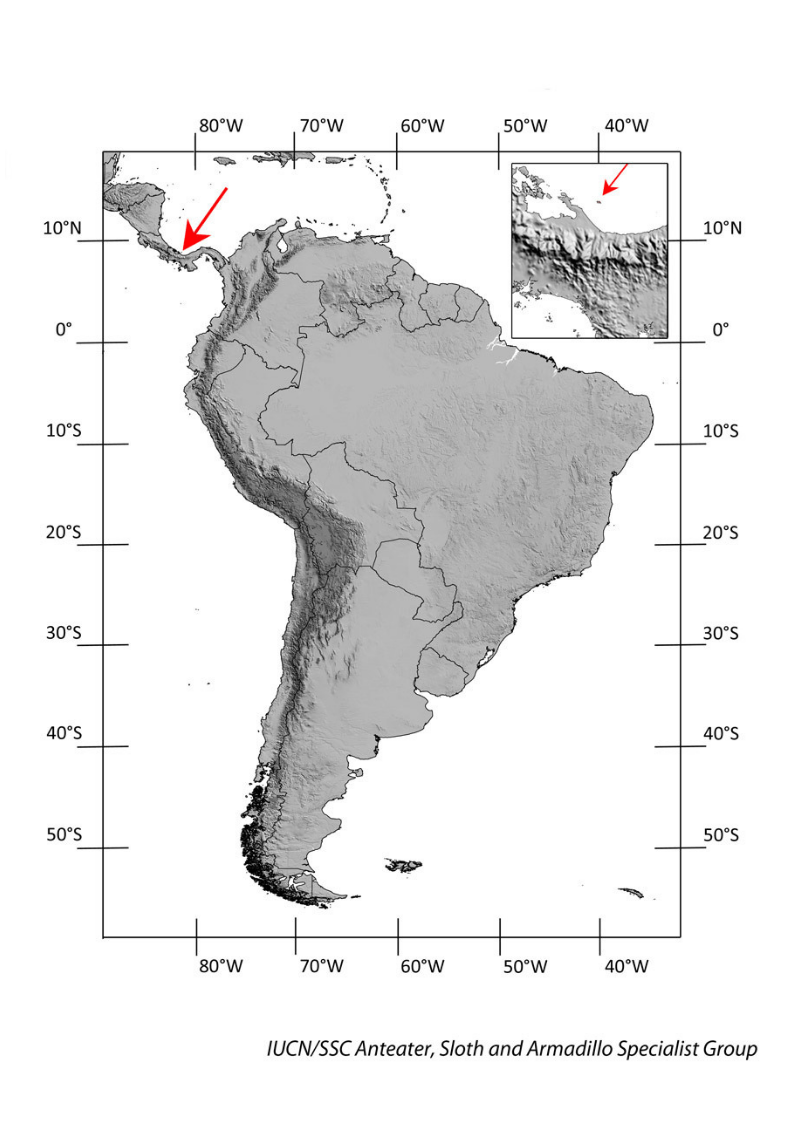Pygmy three-toed sloth
(Bradypus pygmaeus)
other common names
Pygmy sloth
Taxonomy
Order: Pilosa
Family: Bradypodidae


description
This is the smallest sloth species. It has a head-body length of around 50 cm and weighs 2.5–3.5 kg. Its fur is gray with long, coarse hair, covered with algae causing hair to appear green. Pygmy sloths have a dark stripe around the eyes over a lighter colored and browner face. Males have a dorsal speculum of shorter cream to orange hair. As all sloths of the genus Bradypus, this species has three large and distinct claws on the forelimbs.

diet
Its diet is not well known. It has been observed eating leaves from mangroves and other species, such as Cecropia.

range
The pygmy sloth is known only from Isla Escudo de Veraguas, in the islands of Bocas del Toro, Panama. Isla Escudo de Veraguas has an area of approximately 4.3 km² and is about 17.6 km from the mainland of Panama.

Population trend

curious facts
The fur is greenish due to the presence of algae, which allows pygmy sloths to hide among the vegetation.

reproduction
There is no information about the reproductive cycle or strategy of pygmy sloths.

threats
Although the island is uninhabited, there are seasonal visitors (fishermen, campesinos, lobster divers, tourists, and local people) who harvest timber to maintain wooden houses on the island. Preliminary studies suggest a reduced level of genetic diversity for pygmy sloths compared to its putative population of origin, the common sloth population from mainland Panama. This is expected, considering the history of species diversification and isolation on the island. However, signs of a more recent population bottleneck were also detected.
These results highlight the need of a continuous evaluation of the population status, trends, and additional studies considering a possible scenario of endogamic depression if the (already low) population size decreases any further. Despite having been designated as a protected landscape through a governmental resolution in 2009, a number of domestic and international efforts have been mounted to develop tourism infrastructure on the island. The increased interest in using the island for touristic purposes exponentially increases the number of local visitors and tourists. On the other hand, the intentions of local indigenous people to build permanent settlements on the island have increased the number of permitted constructions, putting the pygmy sloths and their habitat at risk.
The current status of the island’s custody is vague; a governmental resolution, and thus the protected status of the island, cannot be revoked, but no government staff has been appointed specifically to enforce protection of the island. Ongoing disagreements between the local Ngäbe bugle Comarca, regional politicians, and the Panamanian government are further complicating long-term protection of the island and the pygmy sloths. Additionally, as pygmy sloths have become more widely recognized internationally, there is growing interest in collecting them for captivity.

HaBITAT and ECOLOGy
This sloth species is found both in mangrove patches and on the interior of Isla Escudo. Although previously thought to exclusively inhabit the red mangroves of the island, recent tracking studies have found the sloths on the interior of the island, in dense tropical rainforest. Because of the difficulty of censusing cryptic canopy mammals, their density and abundance in the thicker forests is unknown. Pygmy sloths are mainly arboreal, but they can also swim and slowly move on the ground.

conservation status
The pygmy sloth is listed as Critically Endangered as this species has a very restricted range, being found only on one very small island less than 5 km² in size, and there is likely a continuing decline in the quality of habitat and area of occupancy due to habitat degradation. It is listed on CITES Appendix II.